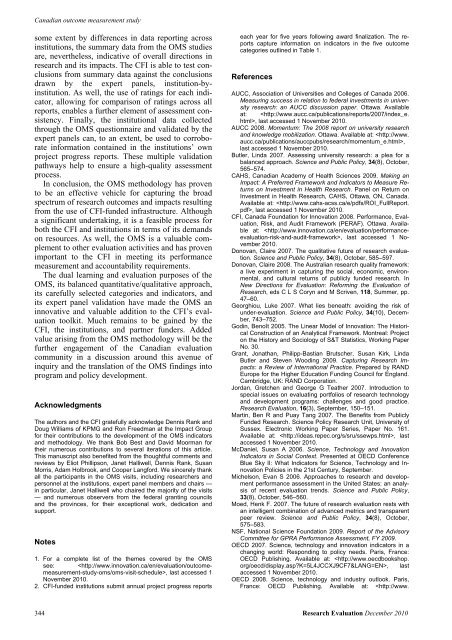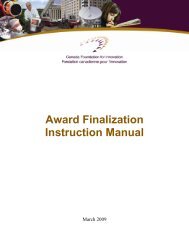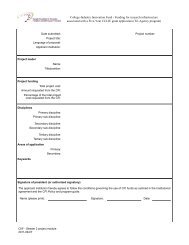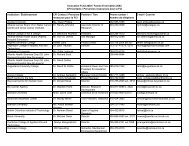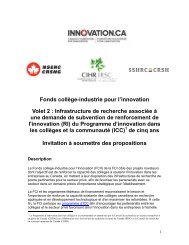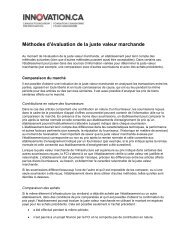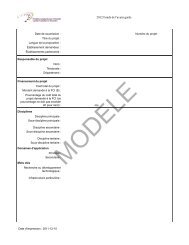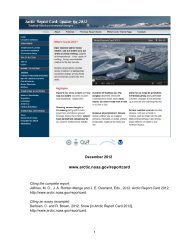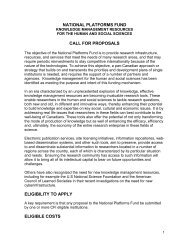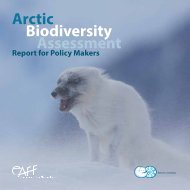Download - Canada Foundation for Innovation
Download - Canada Foundation for Innovation
Download - Canada Foundation for Innovation
Create successful ePaper yourself
Turn your PDF publications into a flip-book with our unique Google optimized e-Paper software.
Canadian outcome measurement study<br />
some extent by differences in data reporting across<br />
institutions, the summary data from the OMS studies<br />
are, nevertheless, indicative of overall directions in<br />
research and its impacts. The CFI is able to test conclusions<br />
from summary data against the conclusions<br />
drawn by the expert panels, institution-byinstitution.<br />
As well, the use of ratings <strong>for</strong> each indicator,<br />
allowing <strong>for</strong> comparison of ratings across all<br />
reports, enables a further element of assessment consistency.<br />
Finally, the institutional data collected<br />
through the OMS questionnaire and validated by the<br />
expert panels can, to an extent, be used to corroborate<br />
in<strong>for</strong>mation contained in the institutions’ own<br />
project progress reports. These multiple validation<br />
pathways help to ensure a high-quality assessment<br />
process.<br />
In conclusion, the OMS methodology has proven<br />
to be an effective vehicle <strong>for</strong> capturing the broad<br />
spectrum of research outcomes and impacts resulting<br />
from the use of CFI-funded infrastructure. Although<br />
a significant undertaking, it is a feasible process <strong>for</strong><br />
both the CFI and institutions in terms of its demands<br />
on resources. As well, the OMS is a valuable complement<br />
to other evaluation activities and has proven<br />
important to the CFI in meeting its per<strong>for</strong>mance<br />
measurement and accountability requirements.<br />
The dual learning and evaluation purposes of the<br />
OMS, its balanced quantitative/qualitative approach,<br />
its carefully selected categories and indicators, and<br />
its expert panel validation have made the OMS an<br />
innovative and valuable addition to the CFI’s evaluation<br />
toolkit. Much remains to be gained by the<br />
CFI, the institutions, and partner funders. Added<br />
value arising from the OMS methodology will be the<br />
further engagement of the Canadian evaluation<br />
community in a discussion around this avenue of<br />
inquiry and the translation of the OMS findings into<br />
program and policy development.<br />
Acknowledgments<br />
The authors and the CFI gratefully acknowledge Dennis Rank and<br />
Doug Williams of KPMG and Ron Freedman at the Impact Group<br />
<strong>for</strong> their contributions to the development of the OMS indicators<br />
and methodology. We thank Bob Best and David Moorman <strong>for</strong><br />
their numerous contributions to several iterations of this article.<br />
This manuscript also benefited from the thoughtful comments and<br />
reviews by Eliot Phillipson, Janet Halliwell, Dennis Rank, Susan<br />
Morris, Adam Holbrook, and Cooper Lang<strong>for</strong>d. We sincerely thank<br />
all the participants in the OMS visits, including researchers and<br />
personnel at the institutions, expert panel members and chairs —<br />
in particular, Janet Halliwell who chaired the majority of the visits<br />
— and numerous observers from the federal granting councils<br />
and the provinces, <strong>for</strong> their exceptional work, dedication and<br />
support.<br />
Notes<br />
1. For a complete list of the themes covered by the OMS<br />
see: ,<br />
last accessed 1<br />
November 2010.<br />
2. CFI-funded institutions submit annual project progress reports<br />
each year <strong>for</strong> five years following award finalization. The reports<br />
capture in<strong>for</strong>mation on indicators in the five outcome<br />
categories outlined in Table 1.<br />
References<br />
AUCC, Association of Universities and Colleges of <strong>Canada</strong> 2006.<br />
Measuring success in relation to federal investments in university<br />
research: an AUCC discussion paper. Ottawa. Available<br />
at: , last accessed 1 November 2010.<br />
AUCC 2008. Momentum: The 2008 report on university research<br />
and knowledge mobilization. Ottawa. Available at: ,<br />
last accessed 1 November 2010.<br />
Butler, Linda 2007. Assessing university research: a plea <strong>for</strong> a<br />
balanced approach. Science and Public Policy, 34(8), October,<br />
565–574.<br />
CAHS, Canadian Academy of Health Sciences 2009. Making an<br />
Impact: A Preferred Framework and Indicators to Measure Returns<br />
on Investment in Health Research. Panel on Return on<br />
Investment in Health Research, CAHS, Ottawa, ON, <strong>Canada</strong>.<br />
Available at: , last accessed 1 November 2010.<br />
CFI, <strong>Canada</strong> <strong>Foundation</strong> <strong>for</strong> <strong>Innovation</strong> 2008. Per<strong>for</strong>mance, Evaluation,<br />
Risk, and Audit Framework (PERAF). Ottawa. Available<br />
at: ,<br />
last accessed 1 November<br />
2010.<br />
Donovan, Claire 2007. The qualitative future of research evaluation.<br />
Science and Public Policy, 34(8), October, 585–597.<br />
Donovan, Claire 2008. The Australian research quality framework:<br />
a live experiment in capturing the social, economic, environmental,<br />
and cultural returns of publicly funded research. In<br />
New Directions <strong>for</strong> Evaluation: Re<strong>for</strong>ming the Evaluation of<br />
Research, eds C L S Coryn and M Scriven, 118, Summer, pp.<br />
47–60.<br />
Georghiou, Luke 2007. What lies beneath: avoiding the risk of<br />
under-evaluation. Science and Public Policy, 34(10), December,<br />
743–752.<br />
Godin, Benoît 2005. The Linear Model of <strong>Innovation</strong>: The Historical<br />
Construction of an Analytical Framework. Montreal: Project<br />
on the History and Sociology of S&T Statistics, Working Paper<br />
No. 30.<br />
Grant, Jonathan, Philipp-Bastian Brutscher, Susan Kirk, Linda<br />
Butler and Steven Wooding 2009. Capturing Research Impacts:<br />
a Review of International Practice. Prepared by RAND<br />
Europe <strong>for</strong> the Higher Education Funding Council <strong>for</strong> England.<br />
Cambridge, UK: RAND Corporation.<br />
Jordan, Gretchen and George G Teather 2007. Introduction to<br />
special issues on evaluating portfolios of research technology<br />
and development programs: challenges and good practice.<br />
Research Evaluation, 16(3), September, 150–151.<br />
Martin, Ben R and Puay Tang 2007. The Benefits from Publicly<br />
Funded Research. Science Policy Research Unit, University of<br />
Sussex. Electronic Working Paper Series, Paper No. 161.<br />
Available at: , last<br />
accessed 1 November 2010.<br />
McDaniel, Susan A 2006. Science, Technology and <strong>Innovation</strong><br />
Indicators in Social Context. Presented at OECD Conference<br />
Blue Sky II: What Indicators <strong>for</strong> Science, Technology and <strong>Innovation</strong><br />
Policies in the 21st Century, September.<br />
Michelson, Evan S 2006. Approaches to research and development<br />
per<strong>for</strong>mance assessment in the United States: an analysis<br />
of recent evaluation trends. Science and Public Policy,<br />
33(8), October, 546–560.<br />
Moed, Henk F. 2007. The future of research evaluation rests with<br />
an intelligent combination of advanced metrics and transparent<br />
peer review. Science and Public Policy, 34(8), October,<br />
575–583.<br />
NSF, National Science <strong>Foundation</strong> 2009. Report of the Advisory<br />
Committee <strong>for</strong> GPRA Per<strong>for</strong>mance Assessment, FY 2009.<br />
OECD 2007. Science, technology and innovation indicators in a<br />
changing world: Responding to policy needs. Paris, France:<br />
OECD Publishing. Available at: , last<br />
accessed 1 November 2010.<br />
OECD 2008. Science, technology and industry outlook. Paris,<br />
France: OECD Publishing. Available at:


